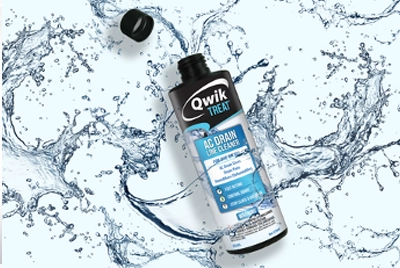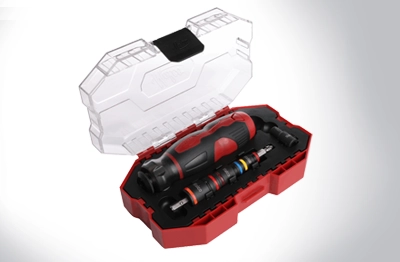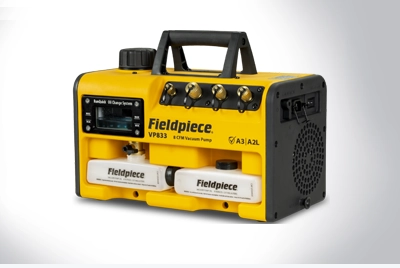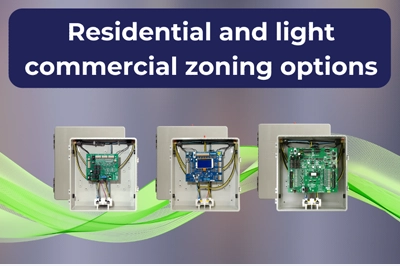A major concern, particularly in more affluent neighborhoods, is noise (unwanted sound). Of all the possible sources of noise, the exterior components of an HVACR system rate high on the list of complaints. Knowing what is causing the noise, and how to address it, can be a key element in preserving your reputation as a supplier and installer of quality equipment.
Noise is produced from vibration or air turbulence. In HVACR systems of any size, the major noise-producing components are compressors and cooling fans. Secondary sources may include pumps and associated piping.
Rule #1: Know how much noise your equipment produces and what is allowable where it is to be installed.
Many state, county, and local governments set noise limits. These levels are usually determined by land use, and spelled out in zoning regulations. Allowable nighttime levels may be as low as 40 decibels (dB) at a residential property line. Since HVACR equipment may be running 24/7, it is important that the specifier (and often the supplier or installer) help assure that such equipment not violate these restrictions.
Most equipment suppliers can tell you how much noise their equipment will produce. The results of the manufacturer’s sound tests are often given as a sound power level, while readings at a given distance from the equipment are expressed as the sound pressure level. Using the sound power level, and knowing the environment where the equipment is to be installed, an engineer can quite accurately predict what the sound pressure level and frequency spectrum will be at a distant location.
Sound is additive. With a unit mounted against a wall, the reflective surface of the wall may well cause an increase in the sound level of up to 3dB. Multiple units will also cause a buildup of the noise level. As an example, four similar units running at the same time will increase the noise level by 5-6dB over that produced by only one unit.
In a non-reflective environment, the sound pressure level for low and mid-frequency noise decays about 6dB for every doubling of the distance from a source. For example, a ground-installed residential A/C exterior unit generating a noise level of 72dB at 3’ in a free-field may, when installed against a finished concrete wall, produce 75dB. If the property line of the residence next door is 50’ away, the sound pressure level will still be over 50dB – and may violate a local noise ordinance.
Rule #2: Isolate all vibrating elements from the equipment shell or structure
Both fans and compressors produce vibration – the result of unbalanced forces. Reciprocating elements produce more vibration than balanced rotating elements, and, generally speaking, there is less vibration produced by better engineered and constructed products. In any installation, vibration must be isolated from the supporting structure – and even from the ground if the system is large. This is done by mounting the vibrating elements using resilient isolators, which are selected based upon the weight of the equipment, the speed of rotation or reciprocation, and the amount of acceptable vibration transmissibility.
Rule #3: Make absolutely sure that proper isolation is selected
The purpose of the isolation is to minimize the amount of surface set into motion. An improperly isolated compressor, for instance, can cause the entire metal shell of the enclosure to become a speaker – radiating sound in all directions. (In a rooftop installation, poor or deteriorated isolation can cause structural vibration leading to unbearably annoying low frequency sound throughout a high rise housing unit – particularly in the premium penthouse real estate – but that’s another issue.)
An improperly selected isolation package can be worse than no isolation at all. If the natural frequency of the isolator is close to the forcing frequency of the vibration, a resonant condition may be set up and that vibration will actually be amplified. For a given speed of rotation, the amount of deflection in the isolator generally determines its effectiveness. For low frequency vibration, it may even be necessary to use high deflection springs or even air mounts with a massive inertia base to provide effective isolation.
Other factors also come into play, so be sure that you are getting advice from a competent supplier who can assist with the proper isolator selection. Even with resilient connections, which should always be specified, vibration from the rotating or reciprocating equipment can also transmit through pipes and conduits into the structure. Any residual vibration in metal shell of an exterior system can be reduced or eliminated by applying damping material appropriate to the frequency of vibration and the thickness of the shell.

Photos courtesy of Kinetics Noise Control, Inc.
Rule #4: Consider changing fan blade design or fan speed
With compressor, fan and piping vibration isolated, most of the noise results from high speed airflow. This noise is caused by air turbulence and, depending upon the fan speed and air volume, may be clearly heard for miles.
Some fan blades, usually the cheapest, produce much more noise than others. Recently, just swapping the flat bladed fan on a residential A/C unit with a slightly more expensive “turbine style” blade reduced the noise level 10dB – which is perceived as cutting the noise level in half. Getting the manufacturer, a prominent name in the industry, to make things right was like pulling teeth.
Reducing the fan speed is usually also effective in reducing the amount of noise from the fan. In a recent commercial installation, changing to variable speed fan motors with temperature control not only reduced noise but will save enough energy to pay for the change.
Rule #5: Block noise transmission with partial noise barriers placed as close as possible to the equipment
There are three places to control noise: At the source, along the path, and at the receiver. When using a partial noise barrier to block the transmission of sound, you interrupt the path of the noise. The effectiveness of the barrier is maximized by constructing it as close as possible to the equipment, without restricting airflow, and making it wide and high enough to minimize the amount of “flanking” of the sound around it. Partial barriers, as shown in the photos, are very effective in reducing directional mid and high-frequency noise.
To prevent sound buildup inside the barrier, it is desirable to incorporate sound absorption, appropriately selected for the frequency of the noise being produced. Many barriers include absorption. The least expensive noise barriers, as shown in the second photo, are constructed of flexible reinforced mass-loaded vinyl curtains with quilted faced absorption.

Partial barrier photos courtesy of Oshex Associates, Inc.
Rule #6: Use acoustic silencers or vent louvers to control intake and exhaust air noise
When equipment is located inside an enclosure, it is essential that adequate airflow be maintained. This may mean compromising an otherwise effective noise barrier. To minimize the impact of an opening, the air may be drawn or expelled through a silencer or “acoustic louver.” In this configuration, the airflow is routed through a sound absorbing “tunnel,” resulting in less noise with minimal airflow restriction.

Photo courtesy of the Vibron Division of Kinetics Noise Control, Inc.
Rule #7: Never ignore a community noise complaint!
If there’s one thing I have learned in nearly forty years working with community noise issues, it is to never ignore or try to minimize complaints. Unresolved noise issues can be extremely disruptive. Whatever your role in specifying, providing or installing HVACR equipment, your reputation can be on the line – and little can be more damaging than having angry neighbors writing letters to the media, calling elected representatives, or spreading their discontent across the Internet.
The bottom line is: Do it right the first time – and don’t hesitate to seek advice from a competent professional! Often, a simple solution can save a lot of grief.
Robert N. Andres, Sr. is the founder of Oshex Associates, Inc., Baldwinsville, NY (1-800-LESS-LOUD), specialists in industrial, community and building noise and vibration measurement and control since 1975. He is a Certified Safety Professional, Board Certified Forensic Examiner, a member of the Institute of Noise Control Engineering, and is the principal of Environmental and Safety Associates, LLC, of Naples, FL and Syracuse, NY, specialists in noise and vibration control and machine safety. He may be reached at esaconsulting@comcast.net.









